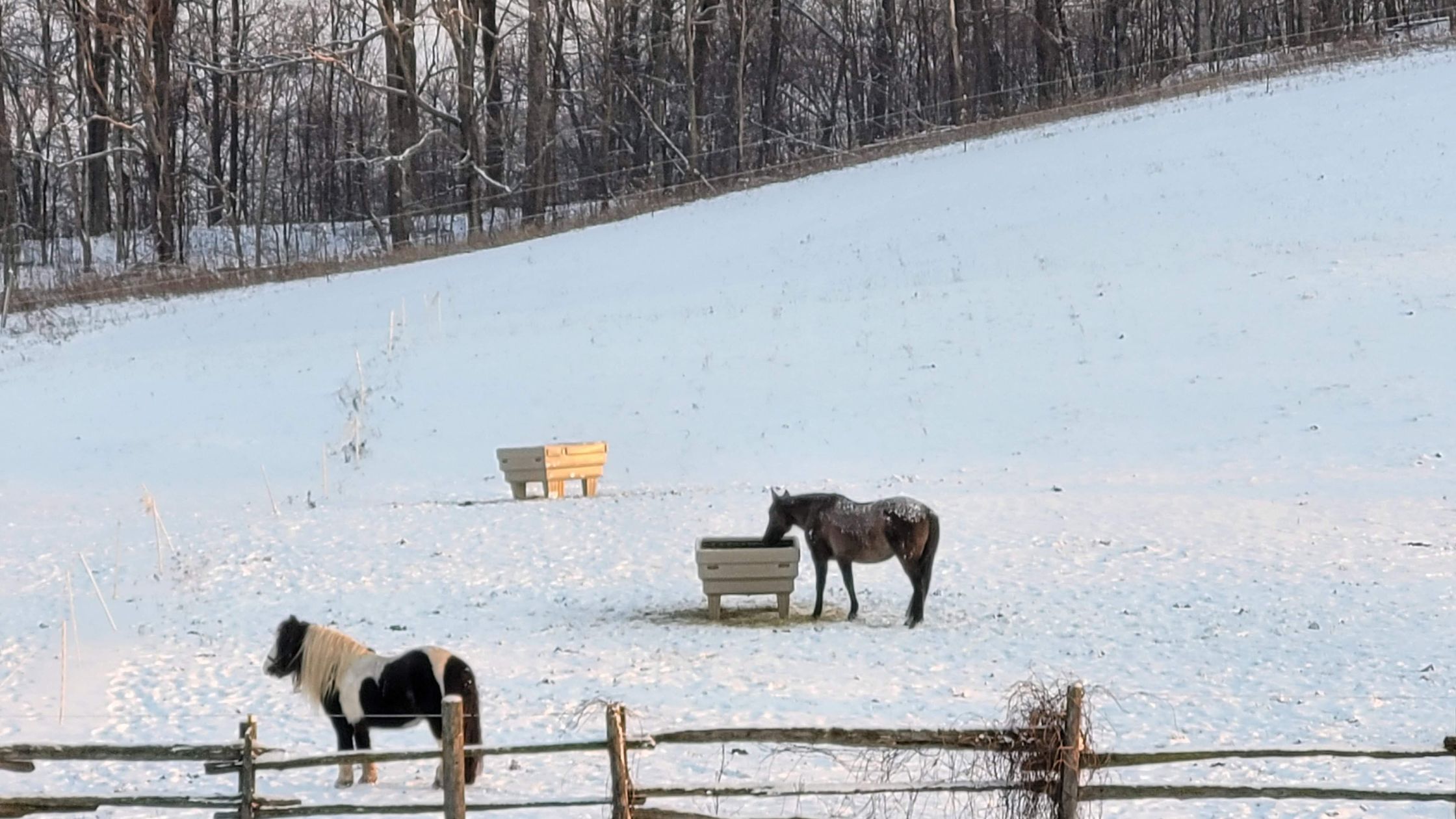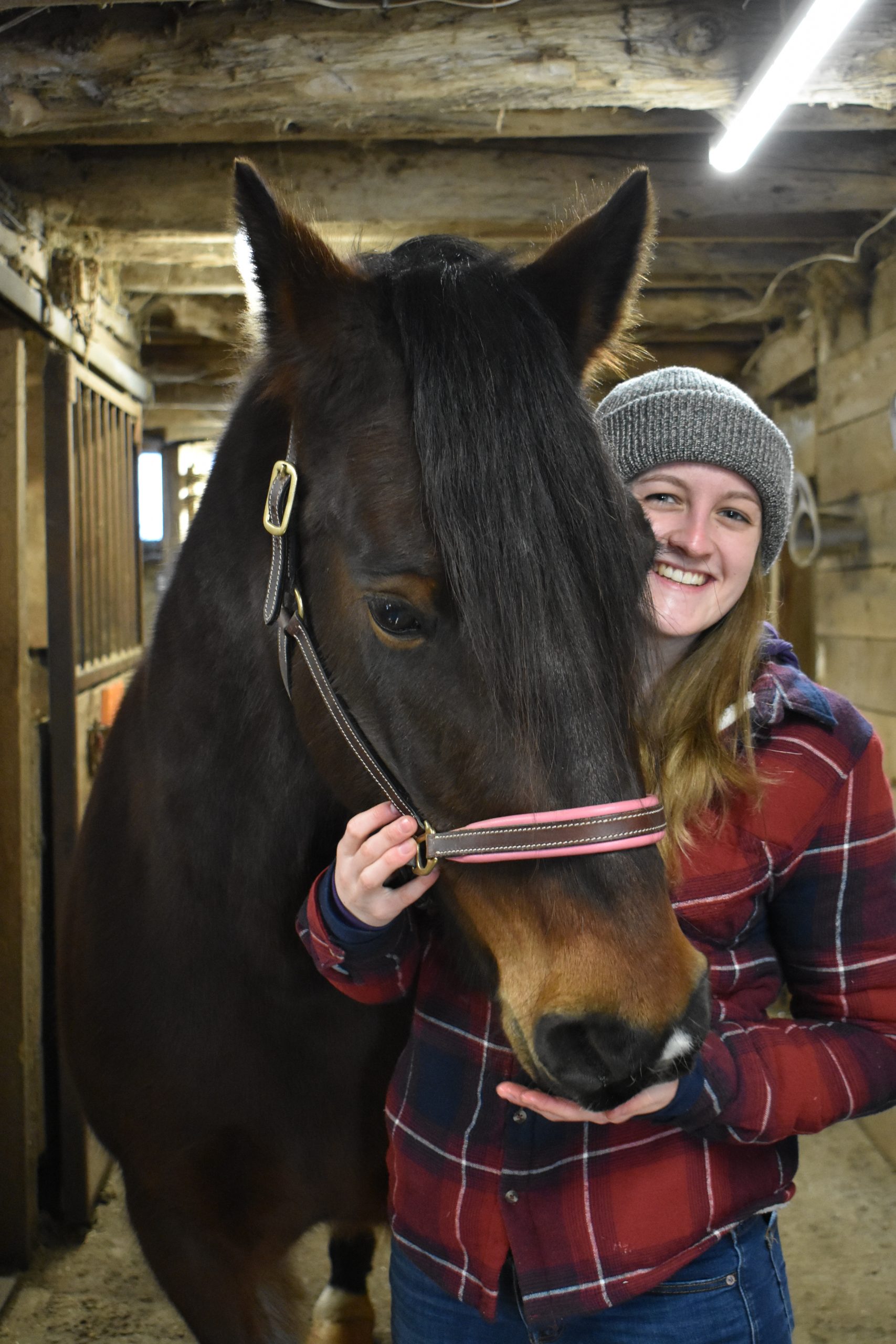Taking care of horses in the winter can seem difficult, but they can do extremely well in cold temperatures when given some extra supports. Part of the reason that horses acclimatize well to the cold is because they have evolved with physiological adaptations. When days begin to shorten, their coat growing thicker is not the only change. Their digestion changes, they slow their respiratory rate, and they reduce blood flow to extremities.
For wild horses, the availability of feed decreases in the winter. The quality of what is available also decreases. Although not the same, it is similar for domestic horses. During the winter months, fresh pasture is not available to horses, and they consume a hay diet. Research in wild horses has shown that gut transit time is altered depending on season. In the spring when consuming nutrient rich pasture, the transit time is faster. When these same horses consume a diet lower in protein and higher in crude fiber their transit time slows. This winter climate adaptation has been shown in domestic horses as well.
A fact to be aware of as a horse owner is the lower critical temperature (LCT). Not all horses have the same LCT. It depends on a variety of factors: age, breed, health status, forage availability, shelter, allowance of adaptation time, etc. A mature horse in good health that has had time to adapt to the cold climate will typically have a LCT around 5°F (-15°C). An example of a horse with a different LCT would be if you move a horse that lives in a warm climate (e.g., Florida) to Northern Ontario in the winter – they will have a LCT much higher than 5°F.
So, when the temperature falls below the LCT, what happens?
No need to panic, your horse will just need human intervention such as additional forage as well as shelter to stay warm. When horses are exposed to cold temperatures, their main source of warmth comes from feed with a high heat increment—hay!
How Does Forage Help Horses Thrive in the Winter?
Horses digest certain feedstuffs differently. When fed fibrous forage, it is fermented in the hindgut. This process involves microbes that produce volatile fatty acids. A critical by-product of this process is heat! By comparison, grain provides calories but does not contribute to warmth the same way hay does.
The difference in their contributions to heat are because the horse digests them different.
- Forages are digested in the hindgut with the help of the microbial population in the horse’s gut. This digestion produces volatile fatty acids (VFAs). These help the horse to stay warm because heat is produced in the digestion process.
- In contrast, grains are digested earlier in the gastrointestinal tract. They are primarily digested in the small intestine and therefore do not produce heat during digestion in the same way forages do. Therefore, when housing horses outdoors in the winter, ensuring they have the amount of hay they need is crucial to their comfort.
The above image shows two horses at Wishing Well Farm consuming their forage out of an OptiMizer in the winter.
How Much More Hay Should Your Horse Consume?
It varies from horse to horse, but the general rule is that for every degree Fahrenheit below the LCT the horse needs 2.5% more energy. Below are tables showing the increase in forage needed as temperature drops. These numbers are based on a forage with an energy content of 0.78Mcal/lb. The calculations are based on the energy requirements published by the National Research Council (2007), actual forage requirements can vary based on the individual horse.
| 440 lb (200kg) Horse | ||||||
| Exercise Level | 5°F /-15°C | -4°F/-20°C | -13°F/-25°C | -22°F/-30°C | -31°F/-35°C | -40°F/-40°C |
| Forage Amounts (lb) | ||||||
| Maintenance | 8.5 | 9.6 | 10.6 | 11.7 | 12.8 | 13.8 |
| Light Work | 10.2 | 11.4 | 12.7 | 13.9 | 15.3 | 16.5 |
| Moderate Work | 11.8 | 13.3 | 14.8 | 16.3 | 17.7 | 19.2 |
| Heavy Work | 13.6 | 15.3 | 17.0 | 18.7 | 20.4 | 22.1 |
| 880 lb (400 kg) Horse | ||||||
| Exercise Level | 5°F /-15°C | -4°F/-20°C | -13°F/-25°C | -22°F/-30°C | -31°F/-35°C | -40°F/-40°C |
| Forage Amounts (lb) | ||||||
| Maintenance | 16.9 | 19.0 | 21.1 | 23.2 | 25.3 | 27.5 |
| Light Work | 20.35 | 22.8 | 25.4 | 27.9 | 30.5 | 33.1 |
| Moderate Work | 23.6 | 26.6 | 29.6 | 32.5 | 35.5 | 38.4 |
| Heavy Work | 27.1 | 30.5 | 33.8 | 37.2 | 40.6 | 44.0 |
| 1100 lb (500 kg) Horse | ||||||
| Exercise Level | 5°F /-15°C | -4°F/-20°C | -13°F/-25°C | -22°F/-30°C | -31°F/-35°C | -40°F/-40°C |
| Forage Amounts (lb) | ||||||
| Maintenance | 21.2 | 23.9 | 26.5 | 29.2 | 31.9 | 34.5 |
| Light Work | 25.4 | 28.6 | 31.8 | 34.9 | 38.2 | 41.3 |
| Moderate Work | 29.6 | 33.3 | 37.1 | 40.7 | 44.4 | 48.1 |
| Heavy Work | 33.8 | 38.0 | 42.3 | 46.5 | 50.7 | 54.9 |
| 1320 lb (600 kg) Horse | ||||||
| Exercise Level | 5°F /-15°C | -4°F/-20°C | -13°F/-25°C | -22°F/-30°C | -31°F/-35°C | -40°F/-40°C |
| Forage Amounts (lb) | ||||||
| Maintenance | 25.4 | 28.6 | 31.8 | 34.9 | 38.1 | 41.3 |
| Light Work | 30.5 | 34.3 | 38.1 | 41.9 | 45.8 | 49.6 |
| Moderate Work | 35.6 | 40.1 | 44.5 | 48.9 | 53.4 | 57.8 |
| Heavy Work | 40.7 | 45.8 | 50.8 | 55.9 | 61.0 | 66.1 |
To conclude, the above tables display how forage requirements increase as the temperature decreases. At the Wishing Well Farm, we track the hay consumption of our horses each day by simply writing the number of bales fed in OptiMizers on a calendar. Through this process we have continuously observed how much more our horses need and consume in the cold weather.
References:
Brinkmann, L., Gerken, M., & Riek, A. (2012). Adaptation strategies to seasonal changes in environmental conditions of a domesticated horse breed, the Shetland pony (Equus ferus caballus). Journal of Experimental Biology, 215(7), 1061-1068.
Cymbaluk, N. F. (1994). Thermoregulation of horses in cold, winter weather: a review. Livestock Production Science, 40(1), 65-71.
DeBoer, M., Konop, A., Fisher, B., & Martinson, K. (2020). Dry Matter Intake, Body Weight, and Body Condition Scores of Blanketed and Nonblanketed Horses in the Upper Midwest. Journal of Equine Veterinary Science, 94, 103239.
Garber, A., Hastie, P., & Murray, J. A. (2020). Factors influencing equine gut microbiota: Current knowledge. Journal of Equine Veterinary Science, 88, 102943.
Kuntz, R., Kubalek, C., Ruf, T., Tataruch, F., & Arnold, W. (2006). Seasonal adjustment of energy budget in a large wild mammal, the Przewalski horse (Equus ferus przewalskii) I. Energy intake. Journal of Experimental Biology, 209(22), 4557-4565.
Mejdell, C. M., Bøe, K. E., & Jørgensen, G. H. (2020). Caring for the horse in a cold climate—Reviewing principles for thermoregulation and horse preferences. Applied Animal Behaviour Science, 231, 105071.
National Research Council. 2007. Nutrient Requirements of Horses: Sixth Revised Edition. Washington, DC: The National Academies Press. https://doi.org/10.17226/11653.

